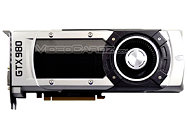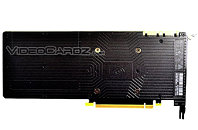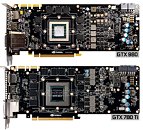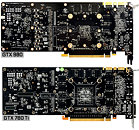- Joined
- Oct 9, 2007
- Messages
- 47,895 (7.38/day)
- Location
- Dublin, Ireland
| System Name | RBMK-1000 |
|---|---|
| Processor | AMD Ryzen 7 5700G |
| Motherboard | Gigabyte B550 AORUS Elite V2 |
| Cooling | DeepCool Gammax L240 V2 |
| Memory | 2x 16GB DDR4-3200 |
| Video Card(s) | Galax RTX 4070 Ti EX |
| Storage | Samsung 990 1TB |
| Display(s) | BenQ 1440p 60 Hz 27-inch |
| Case | Corsair Carbide 100R |
| Audio Device(s) | ASUS SupremeFX S1220A |
| Power Supply | Cooler Master MWE Gold 650W |
| Mouse | ASUS ROG Strix Impact |
| Keyboard | Gamdias Hermes E2 |
| Software | Windows 11 Pro |
Here are the first pictures of the reference-design GeForce GTX 980 graphics card. This gorgeous looking board is something to get used to, as it could be a while before we see non-reference boards for the GTX 980. Its smaller sibling, the GTX 970, could launch with non-reference design boards right off the bat. Outwardly, the GTX 980 looks exactly like a GeForce GTX 780 reference board, with NVIDIA's space-age cooling shroud.
The only difference here is a metal backplate decking up the card. This backplate isn't cooling anything, and traces reveal that the card is indeed holding just 8 memory chips, confirming its 256-bit wide GDDR5 memory interface. The GeForce GTX 980 is based on NVIDIA's new GM204 silicon, a derivative of the company's new "Maxwell" architecture, which made its debut with the GeForce GTX 750 Ti. The package of GM204 looks roughly as big as a GK104. The card draws power from a pair of 6-pin PCIe power connectors, and uses a 4+1 phase VRM to condition power.




View at TechPowerUp Main Site
The only difference here is a metal backplate decking up the card. This backplate isn't cooling anything, and traces reveal that the card is indeed holding just 8 memory chips, confirming its 256-bit wide GDDR5 memory interface. The GeForce GTX 980 is based on NVIDIA's new GM204 silicon, a derivative of the company's new "Maxwell" architecture, which made its debut with the GeForce GTX 750 Ti. The package of GM204 looks roughly as big as a GK104. The card draws power from a pair of 6-pin PCIe power connectors, and uses a 4+1 phase VRM to condition power.




View at TechPowerUp Main Site





